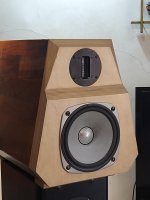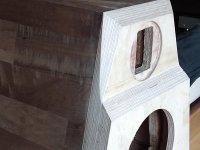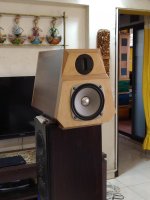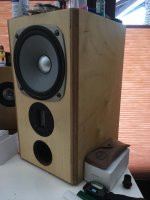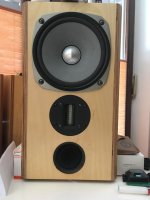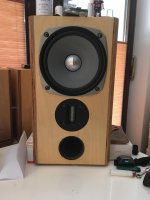Designing a 2-way standmount: Fostex FF225WK 8" and Aurum Cantus G2Si ribbon
Hi all,
Am in the process of designing and building a 2-way standmount with the Fostex FF225WK and the Aurum Cantus G2Si tweeter. (Why these drivers? Well, I've had a pair of G2Si lying around for more than a decade, and I suddenly realised that I need to build a small high-sensitivity standmount pair for a small room, to be driven by a SET amp. So, I chose these. Maybe I could have chosen some other 8" or 10", someone referred me to the PRV 10FR300PR, who knows? But the deed is done.)
Other than the driver selection and the enclosure, nothing else is decided. I'm going for a 34-litre bass reflex design. I built the enclosure using my current practice of using (relatively) inexpensive 18mm ply for internal bracing, 25mm MDF covered in real-wood veneer for the outer shell, and 25mm birch ply for front and rear baffles.
I decided I'll just keep writing all sorts of things I discover or think while taking this project ahead. I'm sure I'll learn a lot from your comments. I'm definitely getting into some new territory here, since this is my first ribbon tweeter (I've already blown one tweeter's ribbon), my first attempt to measure driver distortion, etc.
Some photos of the enclosure build included here. If anyone finds the design interesting enough to want detailed scale drawings, just ask. I'll put them up on my website later anyway -- I always do. This was my first (and only) attempt at doing a stepped baffle with ideas of time alignment. I am not sure of the physics of a 25mm step actually succeeding in time aligning these drivers, so I'll just leave it as it is without arguing about the pros and cons of physical time alignment. Enough has been said in other threads, and I've read them and find the matter inconclusive.
Hi all,
Am in the process of designing and building a 2-way standmount with the Fostex FF225WK and the Aurum Cantus G2Si tweeter. (Why these drivers? Well, I've had a pair of G2Si lying around for more than a decade, and I suddenly realised that I need to build a small high-sensitivity standmount pair for a small room, to be driven by a SET amp. So, I chose these. Maybe I could have chosen some other 8" or 10", someone referred me to the PRV 10FR300PR, who knows? But the deed is done.)
Other than the driver selection and the enclosure, nothing else is decided. I'm going for a 34-litre bass reflex design. I built the enclosure using my current practice of using (relatively) inexpensive 18mm ply for internal bracing, 25mm MDF covered in real-wood veneer for the outer shell, and 25mm birch ply for front and rear baffles.
I decided I'll just keep writing all sorts of things I discover or think while taking this project ahead. I'm sure I'll learn a lot from your comments. I'm definitely getting into some new territory here, since this is my first ribbon tweeter (I've already blown one tweeter's ribbon), my first attempt to measure driver distortion, etc.
Some photos of the enclosure build included here. If anyone finds the design interesting enough to want detailed scale drawings, just ask. I'll put them up on my website later anyway -- I always do. This was my first (and only) attempt at doing a stepped baffle with ideas of time alignment. I am not sure of the physics of a 25mm step actually succeeding in time aligning these drivers, so I'll just leave it as it is without arguing about the pros and cons of physical time alignment. Enough has been said in other threads, and I've read them and find the matter inconclusive.
Attachments
Last edited:
Took impedance measurements of the FF225WK in the enclosure, with my new DATS v3, with the bass reflex port fitted. The twin peaks match almost exactly with the Unibox simulation prediction.
Also took SPL measurement, gated 1 metre, using ARTA.
Then I decided to try my hand at distortion measurements, with both Arta and Steps, from the Arta suite. I use a Focusrite Scarlett 2i2, and a Dayton mic calibrated by Cross Spectrum Labs.
For the Fostex distortion graphs, the graph which says "magnitude and HD, nearfield (5mm)" has been taken with STEPS. STEPS takes a long time, since I was doing 1/24 octave steps. The second one, which says "nearfield mag and HD (ARTA)" has been taken using Arta, using its swept-sine signal, with the mic untouched, the level and gain settings unchanged. This one gets done in about 5 seconds, unless you want averaging over multiple rounds. I just wanted to see what the differences would be with the two methods. These are the very first distortion measurements I've done of any speaker driver.
For the G2Si measurements, I used ARTA for both the SPL measurements and the distortion measurements. I kept an 18uF capacitor in series this time, after I blew my last G2Si while taking measurements without any cap. The mic was about 30mm from the front grille of the tweeter.
Some graphs with a black background, some with white, are irritating. I'll keep a consistent scheme in future.
What should I do about the crossover? I'm tempted to try a 2nd order at about 2.5KHz. The beaming of an 8" driver going up to 2.5KHz won't be as much of a problem in the intended usage of this speaker, since one will listen to it on-axis almost all the time anyway.
The peak in the FF225WK at about 1.5KHz will be audible. The peak at 3KHz will be taken care of by the crossover, I expect.
Before designing the xo, I intend to take off-axis measurements. Will post here when done.
Also took SPL measurement, gated 1 metre, using ARTA.
Then I decided to try my hand at distortion measurements, with both Arta and Steps, from the Arta suite. I use a Focusrite Scarlett 2i2, and a Dayton mic calibrated by Cross Spectrum Labs.
For the Fostex distortion graphs, the graph which says "magnitude and HD, nearfield (5mm)" has been taken with STEPS. STEPS takes a long time, since I was doing 1/24 octave steps. The second one, which says "nearfield mag and HD (ARTA)" has been taken using Arta, using its swept-sine signal, with the mic untouched, the level and gain settings unchanged. This one gets done in about 5 seconds, unless you want averaging over multiple rounds. I just wanted to see what the differences would be with the two methods. These are the very first distortion measurements I've done of any speaker driver.
For the G2Si measurements, I used ARTA for both the SPL measurements and the distortion measurements. I kept an 18uF capacitor in series this time, after I blew my last G2Si while taking measurements without any cap. The mic was about 30mm from the front grille of the tweeter.
Some graphs with a black background, some with white, are irritating. I'll keep a consistent scheme in future.
What should I do about the crossover? I'm tempted to try a 2nd order at about 2.5KHz. The beaming of an 8" driver going up to 2.5KHz won't be as much of a problem in the intended usage of this speaker, since one will listen to it on-axis almost all the time anyway.
The peak in the FF225WK at about 1.5KHz will be audible. The peak at 3KHz will be taken care of by the crossover, I expect.
Before designing the xo, I intend to take off-axis measurements. Will post here when done.
Attachments
-
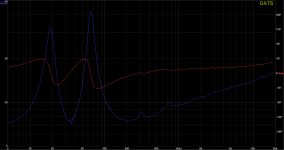 bihagda-midbass-1-Z.png91 KB · Views: 200
bihagda-midbass-1-Z.png91 KB · Views: 200 -
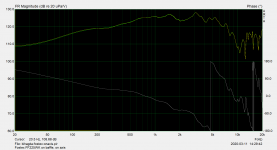 bihagda-midbass-onaxis-SPL.png95.2 KB · Views: 194
bihagda-midbass-onaxis-SPL.png95.2 KB · Views: 194 -
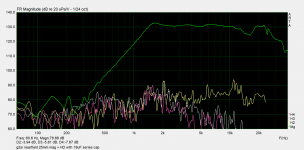 g2si-nearfield-25mm-mag-plus-HD-with-18uF-series-cap.png105.9 KB · Views: 69
g2si-nearfield-25mm-mag-plus-HD-with-18uF-series-cap.png105.9 KB · Views: 69 -
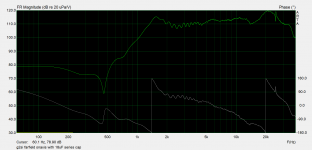 g2si-farfield-onaxis-with18uF-cap.png76.2 KB · Views: 84
g2si-farfield-onaxis-with18uF-cap.png76.2 KB · Views: 84 -
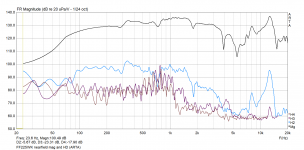 ff225wk-mag-HD-nearfield-arta-sweptsine.png103.9 KB · Views: 93
ff225wk-mag-HD-nearfield-arta-sweptsine.png103.9 KB · Views: 93 -
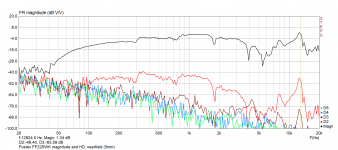 ff225wk-mag-HD-nearfield.png112.7 KB · Views: 87
ff225wk-mag-HD-nearfield.png112.7 KB · Views: 87
Last edited:
I think you have a difficult road ahead, trying to match a ribbon with an 8" driver.
If I was stuck with those components, I'd use the ~2kHz dip on the 8" to introduce the crossover - the dip will help form the final slope. The 3kHz peak might need a small notch, or you could use a steep crossover to knock that down.
The recommended crossover frequency of the ribbon is 2.5kHz, so you'll probably get away with 2kHz if you don't plan on listening too loud.
If I could change the components, I'd be looking at a compression driver or a really really good 1" dome.
Chris
If I was stuck with those components, I'd use the ~2kHz dip on the 8" to introduce the crossover - the dip will help form the final slope. The 3kHz peak might need a small notch, or you could use a steep crossover to knock that down.
The recommended crossover frequency of the ribbon is 2.5kHz, so you'll probably get away with 2kHz if you don't plan on listening too loud.
If I could change the components, I'd be looking at a compression driver or a really really good 1" dome.
Chris
I totally agree with you. Given the choice, I'd never use a ribbon like this in a 2-way -- one needs to cross over too low for the ribbon to handle it well. In fact, I've not been too enamoured of ribbons based on what I've read about them. But I'd bought these ribbons well before I had acquired these nuggets of wisdom. As my reservations about ribbons grew, I left them lying all this time.
So, I know that there will be a sharp difference in the directivity when I move from the 8" to the ribbon. Your idea of the 2K dip was very similar to what I was thinking -- I was wondering if inducing a BBC dip would help. I believe the BBC dip was invented to handle this sudden change in directivity. And I'm hoping to get away with all this a bit more than in the general case, because I will be using these speakers in a small space, 10' x 10', with pretty much on-axis listening.
So maybe I'll go with a 4th order at 2K? If I am forced to use four coils for a 4th order xo, I don't even know if I have enough space inside to fit four coils to minimise their mutual coupling.
If I could start afresh, I'd not use an 8" in a 2-way, unless it was some kind of magical high-dispersing 8". If I didn't have this desire to use up the G2Si, I'd probably use an SB Acoustics SB26ADC 1" dome, which I am told has very low distortion down to 1K, and can be crossed at 1.5K.
What do you think of the distortion plots? Are they representative of what these drivers are like? Am I getting the graphs "right"?
So, I know that there will be a sharp difference in the directivity when I move from the 8" to the ribbon. Your idea of the 2K dip was very similar to what I was thinking -- I was wondering if inducing a BBC dip would help. I believe the BBC dip was invented to handle this sudden change in directivity. And I'm hoping to get away with all this a bit more than in the general case, because I will be using these speakers in a small space, 10' x 10', with pretty much on-axis listening.
So maybe I'll go with a 4th order at 2K? If I am forced to use four coils for a 4th order xo, I don't even know if I have enough space inside to fit four coils to minimise their mutual coupling.
If I could start afresh, I'd not use an 8" in a 2-way, unless it was some kind of magical high-dispersing 8". If I didn't have this desire to use up the G2Si, I'd probably use an SB Acoustics SB26ADC 1" dome, which I am told has very low distortion down to 1K, and can be crossed at 1.5K.
What do you think of the distortion plots? Are they representative of what these drivers are like? Am I getting the graphs "right"?
Last edited:
I think you will be pleasently surprised... I know I was!
These are with the NEO3 from Fountek. 2nd order crossover at 5k.
I use them as desk monitors and the clarity and intellegibilty are quite impressive.
Good luck with your build!
These are with the NEO3 from Fountek. 2nd order crossover at 5k.
I use them as desk monitors and the clarity and intellegibilty are quite impressive.
Good luck with your build!
Attachments
Member
Joined 2009
Paid Member
That's Bohlender Graebener, not Fountek, right? I'm curious -- which of the three variants are you using? There's Neo3, Neo3-PDR, and Neo3-PDRW.I think you will be pleasently surprised... I know I was!
These are with the NEO3 from Fountek. 2nd order crossover at 5k.
I'm so glad that you've done something like this... it gives me hope that it'll work out well, at least in the limited context in which I intend to use it.
Edit: oops, I guess it's the plain Neo3. The other two variants are open back, right? Sorry.
Last edited:
Thanks, pal.tcpip, that’s some very nice wood work and finishing that you’ve done there.
I agree, the whole thing looks physically quite nice. Better than I'd expected. My carpenter has really put in a lot of effort doing that bevelling of the front baffle using just hand tools. Now if only I could get it to sound as good...
Last edited:
Fountek-Lautsprecher Neo CD 3.0
Its this one from Fountek. A pure flat ribbon tweeter. I also had them laying around and wanted to use them for something. I was really impressed at the response. I listen at a distance of approx. .75 to 1 meter and have noticed no issues with dispersion. The FF225WK have a very smooth response and have just a small coil on them to roll off only the highest end with the tweeter coming in around 5k to help out with the high frequencies.
They are also quite sensitive, I have them running with the modulus86 from Neurochrome at the moment and it is more than enough to drive them to ear-bleeding levels. I have also tried my Tubelab SE with 300B tubes and it is also a great match.
Its this one from Fountek. A pure flat ribbon tweeter. I also had them laying around and wanted to use them for something. I was really impressed at the response. I listen at a distance of approx. .75 to 1 meter and have noticed no issues with dispersion. The FF225WK have a very smooth response and have just a small coil on them to roll off only the highest end with the tweeter coming in around 5k to help out with the high frequencies.
They are also quite sensitive, I have them running with the modulus86 from Neurochrome at the moment and it is more than enough to drive them to ear-bleeding levels. I have also tried my Tubelab SE with 300B tubes and it is also a great match.
Ah. The Neo CD3. I had thought the Neo 3, sold on Parts Express. Thanks.
I was hoping for smoother frequency response than what I'm seeing... The peaks in the 1K to 4K region will colour the sound, won't it? The published SPL curve is smoother.The FF225WK have a very smooth response and have just a small coil on them to roll off only the highest end...
Yes, the FATT approach as you put it is a thought.This is upside down FAST or FATT. Fullrange Assisted Tweeter Technology.
It can work well if you use the tweeter as a helper, so try crossing really high - circa 4k and let the full range do it’s thing?
I have not given it much thought, was just taking measurements till now, looking at distortion graphs and pretending to be very technical and wise...Exactly! The ribbon comes in at 5K, just to add some sparkle at the top. I think that is the best solution for this Fostex.
Tcpip, what did you say you were planning for a crossover?
Originally, I was wondering whether I could get the two to work together with an acoustic 2nd order at, say, 2.5K or 3K. Now I'm wondering about (i) a lower Fc, say 2K 4th order, or (ii) a higher Fc, letting the Fostex do its thing almost unhindered.
Basically, am quite unclear. Am rambling. And thinking about what all of you are saying.
This xo will be inexpensive enough to actually let me build two or three flavours for extended trials.
I might be able to save you some time and trouble... I tried 4-5 different variations before I ended up with the current configuration. There is a .5hy coil on the fostex and a 2nd order at 5k on the tweeter. This was the combo that sounded the most natural for me. XRK is right, dont pay too much attention to the graphs, you will drive yourself nuts. Trust your ears and have fun with it!!
If you were going for ruler-flat and lifeless you could have used Morel or Scan-Speak
If you were going for ruler-flat and lifeless you could have used Morel or Scan-Speak
No, you're right, this is not the design which aims for ruler flat above all else.I might be able to save you some time and trouble... I tried 4-5 different variations before I ended up with the current configuration. There is a .5hy coil on the fostex and a 2nd order at 5k on the tweeter. This was the combo that sounded the most natural for me. XRK is right, dont pay too much attention to the graphs, you will drive yourself nuts. Trust your ears and have fun with it!!
If you were going for ruler-flat and lifeless you could have used Morel or Scan-Speak
I'll try your xo approach. I'm guessing you got 2nd order acoustic?
I'm thinking of running the morel cat378.
92db 1w/1m should match the 225wk.
The morel with 5.6uf is -6db @ 2khz and -12db @ 1khz.
I think add a coil to the 225 so it is close to -6db @ 2khz then -12db @4khz.
Directivity would be good for the 8" to hand off at 2khz, I don't mind a dip past 2khz off axis above that.
Slide the tweet back for "time alignment".
I see that peak there though on the 225...………
Whatcha think ?
notch it out
92db 1w/1m should match the 225wk.
The morel with 5.6uf is -6db @ 2khz and -12db @ 1khz.
I think add a coil to the 225 so it is close to -6db @ 2khz then -12db @4khz.
Directivity would be good for the 8" to hand off at 2khz, I don't mind a dip past 2khz off axis above that.
Slide the tweet back for "time alignment".
I see that peak there though on the 225...………
Whatcha think ?
notch it out
Also took SPL measurement, gated 1 metre, using ARTA.
..the scaling on that particular graph needs to be improved (along with color background changes).
The integration window should probably be further away from the loudspeaker, so I'd make my decisions on the crossover at 2+ meters. With particular emphasis on the polar response (mostly horizontal) and the listening axis (..as opposed to the reference 0 degree axis). Lot's of pillows on the floor (spanning the distance between loudspeaker and mic.) tends to help with those further field measurements.
Last edited:
tcpip, that’s some very nice wood work and finishing that you’ve done there.

- Home
- Loudspeakers
- Multi-Way
- Designing a 2-way standmount: FF225WK and G2Si
